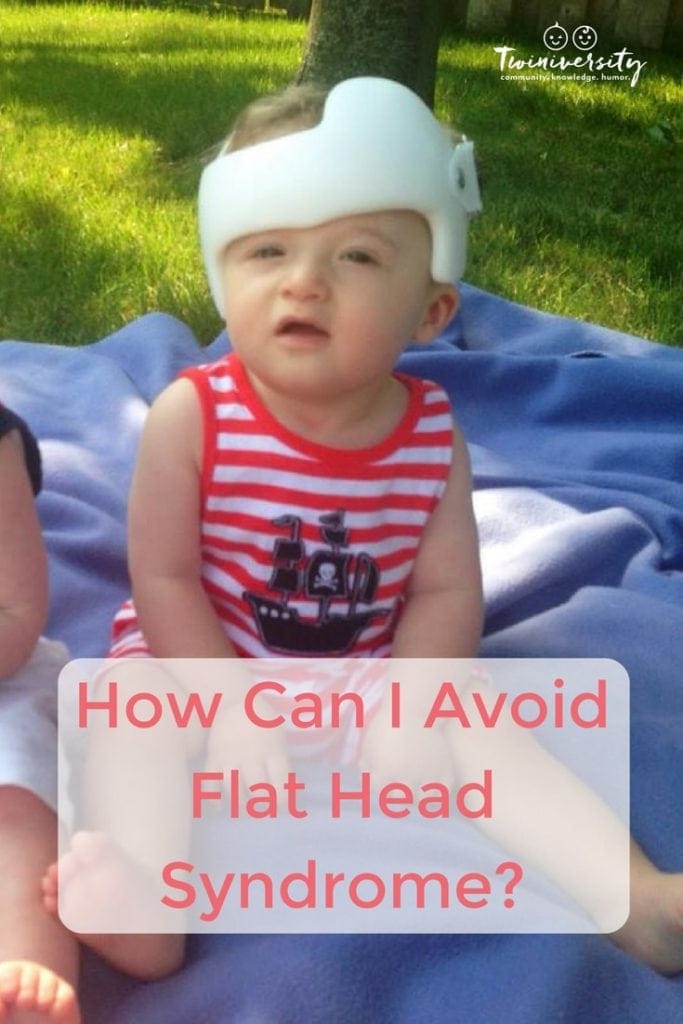Last updated on September 28th, 2021 at 01:43 pm
When I was pregnant with my twins, my son Jacob spent most of the third trimester up in my ribs. The constant pain in my side and nightly dancing on my bladder were the first clues, confirmed later by weekly ultrasounds.
When my babies arrived, they were perfect. Like many moms, I was in a blissful, over-the-moon haze with my little ones. After many long, sleep-deprived nights, my mother-in-law asked me, “At what point should we worry about Jacob’s head?”
I looked at my perfect child, whom I had been staring at for most hours over the last 2 months and realized that I had no idea what she was talking about. “He doesn’t move his head to one side and is developing a flat spot” she said. Thankfully, she noticed.
We had been to the pediatrician at least five times for various visits and the doctor never brought it to our attention. When I raised the issue, at my mother-in-law’s suggestion, our doctor advised that most kids grow out of plagiocephaly or “flat head syndrome,” and we shouldn’t worry. He explained that plagiocephaly is a condition that causes a baby’s head to have a flat spot or be misshapen. The most common form is positional plagiocephaly. It occurs when a baby’s head develops a flat spot due to pressure on that area, but it can also occur in utero when a baby doesn’t have room to move around.
Unfortunately for us, Jacob wasn’t growing out of it.
At 6 months old, he still wasn’t able to turn his head to the right and was eventually diagnosed with torticollis, a tightening of the neck muscles. He needed weekly physical therapy and more aggressive intervention to help reshape his head.
While not all babies will need physical therapy, our therapist offered very useful advice that all new Moms could benefit from:
1. Look out for torticollis.
Torticollis is a twisting on the neck caused by tight neck muscles. If your baby is favoring one direction or not moving their head from side-to-side, they may develop a flat spot. If you notice this, ask your doctor if pediatric physical therapy is something that would help your baby. It can be more common in multiples, as babies have less room to move in utero.
Twiniversity Tip: You don’t need your doctor’s blessing to investigate your child’s possible developmental delay. Contact your state’s Early Intervention program. They will send a team of therapists to your home for a free evaluation to determine if your child qualifies for therapy services, such as physical therapy, speech/feeding therapy, occupational therapy, and ABA therapy. These services are often free or based on a sliding scale to meet your budget.
2. Tummy time.
Start doing tummy time early, from day one at home. This will help them develop their neck and core muscles, which are needed for lifting their head and sitting up. Most babies spend 12-18 hours a day on their back sleeping, so the more of their waking hours they are off the back of their heads, the better.
3. Reposition.
If your baby is always laying on one side of their head, simply reposition the head to the other side. You can do this during waking hours or before they fall asleep. Try using something to stimulate your baby in the direction you want them to look, like a mirror or favorite toy.
4. Switch sides.
I am left-handed and always held my son in the crease of my right arm. I fed him on that side, I held him on that side and I carried him on that side. It also happened to be the side of the flat spot. It’s not easy, but change your habits so that you are holding, and feeding your baby in both arms to decrease the likelihood of putting too much pressure on one side.
5. Consider a reshaping device.
We opted to use a “helmet” (euphemistically known as a “reshaping device”) to help round out the flat side of Jacob’s head. While there is debate among physicians as to the benefits of the helmet, it was the right thing for our family. Jacob’s flat spot was more noticeable, so we didn’t want to take any chances that it wouldn’t correct on its own.
My son is now almost 2, and he has a perfectly round head. Now, the only thing I have to worry about is his love of jumping head first down every slide!
All content on this Website, including medical opinion and any other health-related information, is for informational purposes only and should not be considered to be a specific diagnosis or treatment plan for any individual situation. Use of this site and the information contained herein does not create a doctor-patient relationship. Always seek the direct advice of your own doctor in connection with any questions or issues you may have regarding your own health or the health of others.

Related Articles
How Speech Therapy Has Helped My Twins
Torticollis: A Physical Therapists’ Perspective
Helping Kids Make Sense of Their World: An Occupational Therapist Talks Sensory Intergration










